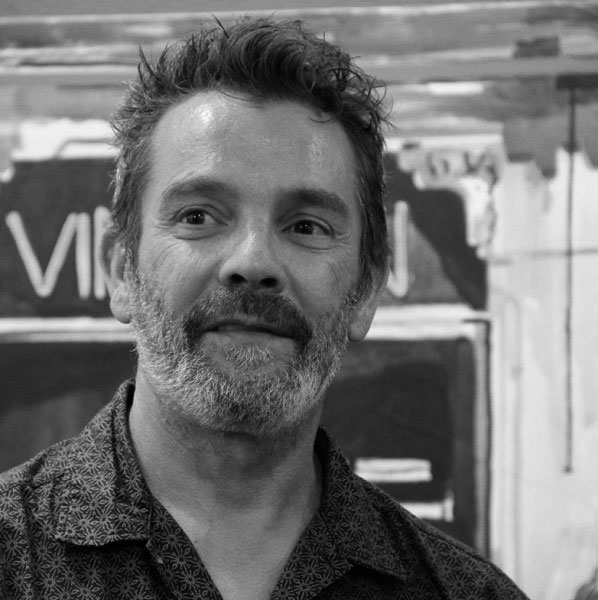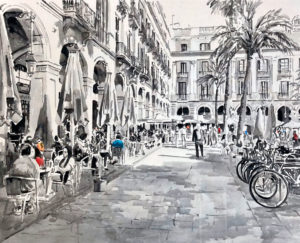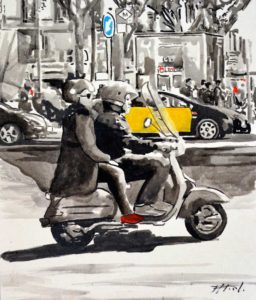BARCELONA, 1963 Abel Florido

Abel Florido loves the city, and he presents it to us in black and white, just like certain artists of photography who see in this binary combination the best way to capture the message with force by letting go of distractions.
Belonging to a new promotion of Barcelona painters, by means of a spontaneous but sure stroke and a dynamic use of the frames, it provides a fresh and direct vision of the main arteries of the Catalan capital and its pedestrians.
THE URBAN LANDSCAPES OF ABEL FLORIDO
by Josep M. Cadena
I remember with satisfaction, both because of the subject matter and the pictorial manner in which he treated it, the previous exhibition held by Abel Florido (Barcelona, 1963) in this same Rusiñol Gallery in Sant Cugat. It was in the months of June and July 2016, and the exhibition aesthetically glossed over the urban traffic, both pedestrians and vehicles, in Barcelona, the great capital of Catalonia. The artist now continues to explore this concept in greater depth, but in a broader way, as he explores other enclaves such as Sant Cugat – his monastery and its historic center – and avenues of large European and North American cities.
We recognize the undulating architectures of La Pedrera, the forms of which, taking nature as their reference, collide with the noise of modern life, in which the rushing motorcycles that buzz in the midst of the human hornet’s nest stand out; the Plaça del Pi, where a café with an old modernist sign invites us to take a break from the daily rush at one of its tables; the Plaça de les Glòries, where Jean Nouvel’s glass and steel tower acts as an icon of our idea of modernity; and the Passeig de Gràcia where the big brands display their products in the store windows.
In contrast to the noise of Barcelona, the representations of Sant Cugat express a calm that symbolizes the monastery, a place of spirituality that encourages us to reflect on the future of our existence and to consider the correct order of our priorities. The city that occupies an area of the Collserola mountain range seems to achieve a better balance between the impossibility of renouncing modern services and the need for a space that is not aggressive to human beings and allows them to live a peaceful and comfortable life.
Abel Florido is a painter with a creative drive, with a very secure stroke, who perfectly combines black and white with color to offer us paintings that portray our daily life and at the same time make us reflect on it, thus achieving what is required of an artist, to provide us with an aesthetic experience, which can lead to a better understanding of the world around us and our own human nature, allowing us to be better.
THE URBAN VIEWS OF ABEL FLORIDO
by Josep M. Cadena
Belonging to a new promotion of Barcelona painters, Abel Florido (Barcelona, 1963), through a spontaneous but sure stroke and a dynamic use of the frames, provides a fresh and direct vision of the main arteries of the Catalan capital and its pedestrians . La Rambla and the emblematic Café de la Ópera, Diagonal and Casa de las Punxes, Passeig de Gràcia and La Pedrera, and other urban elements such as the black and yellow cabs, subway entrances and cyclists, are represented by so much that they allow us to feel immersed in the midst of the citizen’s hustle and bustle.
The protagonists of the paintings are the common people who daily leave home to attend to our work obligations, go shopping or meet with some friends. While we walk, we do not have too much in each other or in the landscape that surrounds us. It is the same that we pass close to a building patrimony of the humanity or of an elegant young person, in the monument we fixed ourselves and to the congener we have erased it of the memory to the few seconds. Therefore, the color of our wandering seems to have to be the gray characteristic of anodyne realities.
But if in our rolling through the streets we know how to look, we will understand that each man and woman, far from being an individual without a relevant personality, constitutes a unique world of experiences and thoughts, that the stones treasure lessons that the ancestors have left us and that the banderole hanging on a street lamp announcing an exhibition by photographer Chema Madoz is the invitation to alter the routine and uninspiring route to direct our steps towards experiences that comfort our spirit.
And it is when we become aware that daily life hides treasures when the gray begins to transform into color. Abel Florido loves the city, and he presents it to us in black and white, just like certain artists in photography who see in this binary combination the best way to make the message come strong, thus avoiding distractions, but adding color notes to tell us, like the idealists of May 1968 in Paris, that under the cobblestones is the beach, it is up to each one to find it.



